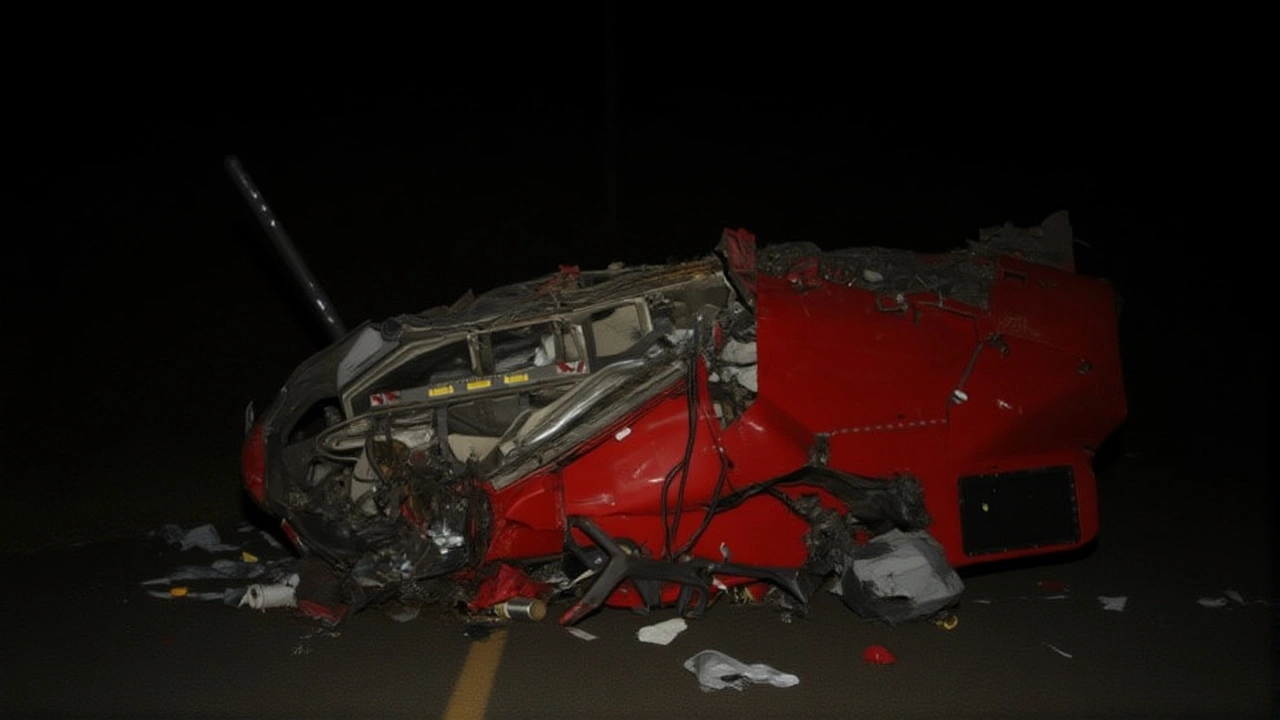When a Air Methods medical helicopter went down on Highway 50 near Sacramento on October 7, 2025, drivers and bystanders rushed to help. The twin‑engine aircraft, outfitted for emergency medical transport, slammed into the eastbound lanes, scattering stretchers, oxygen tanks and a tangled rotor hub across the pavement. Within minutes, the California Highway Patrol (CHP) had the scene blocked off, while a team of at least fifteen investigators from local law‑enforcement and the Federal Aviation Administration began a methodical sweep of the wreckage.
What Happened on the Highway
Witnesses say the rotors were still turning as the aircraft descended, then the hull struck the asphalt with a thud that rattled nearby cars. "It looked like it just dropped out of the sky and settled right on the road," recalled Maria Torres, a commuter who was stopped at a red light. A second driver, who wished to remain anonymous, told reporters they jumped out of their pickup to pull a paramedic’s bag from the wreckage, fearing the equipment might roll into traffic.
The helicopter came to a rest roughly 150 feet from the nearest on‑ramp, its fuselage twisted but still largely intact. Emergency lights flickered intermittently, and a faint smell of jet fuel lingered in the air, prompting nearby motorists to keep a wide berth.
Immediate Response and Rescue Efforts
Within three minutes, CHP officers arrived, establishing a perimeter that stretched for half a mile. "Our priority was to secure the scene, protect the public, and ensure that any surviving crew members received immediate medical attention," said CHP spokesperson Lt. Mark Jensen. Simultaneously, paramedics from the Sacramento Fire Department set up a triage area on the shoulder, though none of the victims were reported injured beyond minor cuts.
Because the helicopter was an active air‑medical unit, its onboard equipment – including a portable ventilator and a blood‑warming device – was quickly gathered by bystanders and handed over to the fire crews. The quick thinking of the public arguably prevented loss of expensive life‑saving gear.
Investigation Into the Crash
The joint investigation team is cataloguing every piece of debris, photographing the scene from multiple angles, and documenting the orientation of the wreckage. Early reports indicate investigators first focused on the starboard side before shifting to the port side, looking for signs of mechanical failure or possible collision with a foreign object.
"We’ll be looking at flight‑data recorder information, maintenance logs, and recent weather conditions," explained FAA investigator Sarah Patel. Weather at the time was clear, with winds from the west at 6 mph – not a factor that would normally endanger a medical flight.
Air Methods has released a statement saying it is "deeply saddened by today’s event" and that a full internal review will run parallel to the FAA’s inquiry. The company declined to name the pilot, citing standard privacy protocols pending family notification.
Impact on Emergency Services and Traffic
Highway 50 remained closed to eastbound traffic for over five hours, rerouting an estimated 12,000 vehicles onto alternate routes. The California Department of Transportation (Caltrans) deployed traffic officers to manage the congestion, and commuters reported delays of up to 45 minutes.
For the region’s emergency medical system, the crash sparked a brief shortage of air‑medical capacity. Air Methods typically handles roughly 30 missions per day in the Sacramento area, and its fleet was down until a replacement aircraft could be dispatched from its nearby base in Modesto.
Experts note that while such crashes are rare, they underscore the importance of redundancy in emergency response. "Ground transport teams have to be ready to pick up the slack when air assets are unavailable," said Dr. Elena Martinez, a professor of emergency medicine at the University of California, Davis.
Historical Context: Helicopter Safety in EMS
According to the National Transportation Safety Board, there have been 69 air‑medical helicopter accidents in the United States since 2015, resulting in 39 fatalities. Most incidents involve mechanical failures or adverse weather, making a clear‑day, low‑altitude crash on a highway an outlier.
Air Methods, founded in 1979, operates one of the largest EMS helicopter fleets in the nation, with over 165 aircraft and a safety record that has earned it the FAA’s "Part 135” operational certification. The company says it conducts quarterly safety drills and adheres to strict maintenance schedules, but no system can eliminate risk entirely.
Local officials have pledged to review air‑traffic protocols over the city’s major thoroughfares, especially after “near‑miss” reports of low‑flying medical aircraft during rush hour. The Sacramento Police Department's aviation unit will be consulted to assess whether existing flight corridors need adjustment.
What Comes Next
Investigators expect to release a preliminary report within 30 days, outlining any immediate safety concerns. In the meantime, Air Methods plans to resume normal operations within a week, pending clearance from the FAA.
Community members who witnessed the crash are being offered counseling services, and a memorial bench is being considered near the crash site to honor the crew members and first responders who acted so swiftly.
Frequently Asked Questions
What caused the Air Methods helicopter to crash?
Investigators are reviewing flight‑data records, maintenance logs, and weather reports. Early indications suggest no weather issue, so focus is on possible mechanical failure or pilot error.
How many people were on board the helicopter?
The aircraft typically carries a pilot, a flight nurse, and a paramedic. Officials have not released exact numbers, but all crew members were safely extracted.
Will this crash affect air‑medical services in Sacramento?
Air Methods will deploy a backup helicopter from its Modesto hub within 24‑48 hours, minimizing disruption. Ground EMS teams are on standby to cover any gaps.
What safety measures are being considered to prevent future crashes?
City officials are reviewing low‑altitude flight paths over Highway 50 and may introduce stricter clearance requirements for medical helicopters during peak traffic hours.
How did the public assist at the crash site?
Bystanders helped retrieve medical equipment, kept traffic clear, and provided first‑aid information to responders until authorities arrived.
